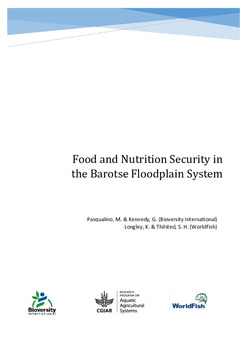Food and nutrition security in the Barotse floodplain system

Citation
Pasqualino, M. et al. (2016). Food and nutrition security in the Barotse floodplain system. CGIAR Research Program on Aquatic Agricultural Systems. Biodiversity International, Italy
The CGIAR Research Program on Aquatic Agricultural Systems (AAS) is being implemented in ten communities in the Barotse floodplain of Zambia's Western Province. With a focus on the rural poor and vulnerable, the AAS program aims to reduce poverty and improve food security by harnessing the development potential, productivity and diversity of aquatic and agricultural systems. The development challenge in the Barotse floodplain, as identified by relevant stakeholders, is to make effective use of seasonal flooding patterns and natural resources through more productive and diversified aquatic agricultural management practices that improve the lives and livelihoods of the poor and vulnerable. Food and nutrition are essential to support the overall AAS program objective and overcome the specific development challenge of the Barotse floodplain. Zambia has very high malnutrition rates, particularly for stunting in children under five. Poor nutritional status, especially of women and children, inhibits individual growth and development, and negatively impacts the overall health, productivity and economic potential of a community. The purpose of this report is to analyze the food and nutrition security situation within the Barotse floodplain. It explores multiple sectors, including nutrition, agriculture, health, and gender, at the national, provincial and community level to provide a comprehensive understanding of food and nutrition in the ten AAS communities in relation to the country as a whole. The analysis will provide informative inputs to the AAS Barotse hub design process to develop an appropriate food and nutrition research-in-development agenda.
Permalink
Date Available
Type
Publisher
Countries
Copyright
CC BY 4.0
Topics